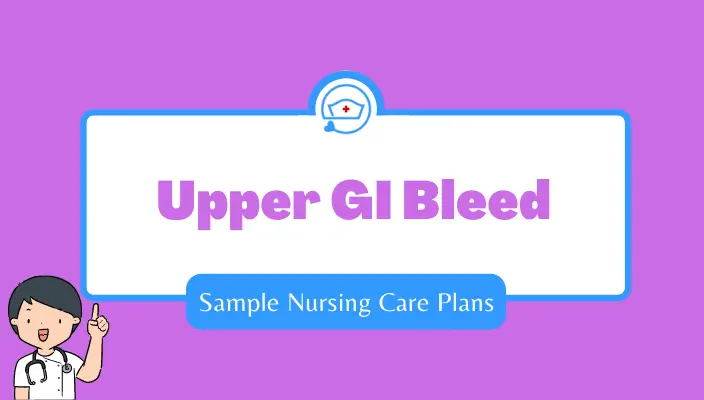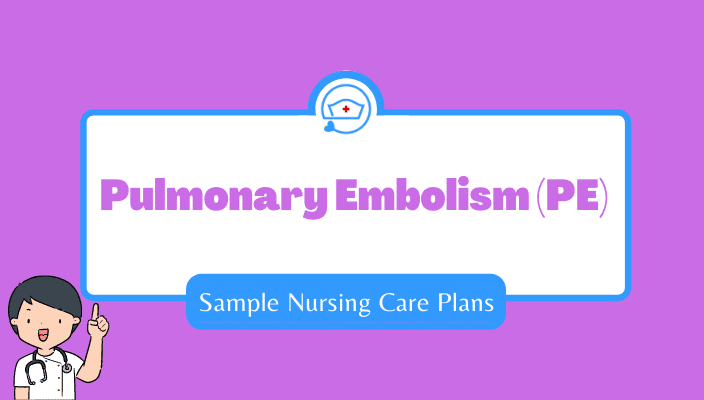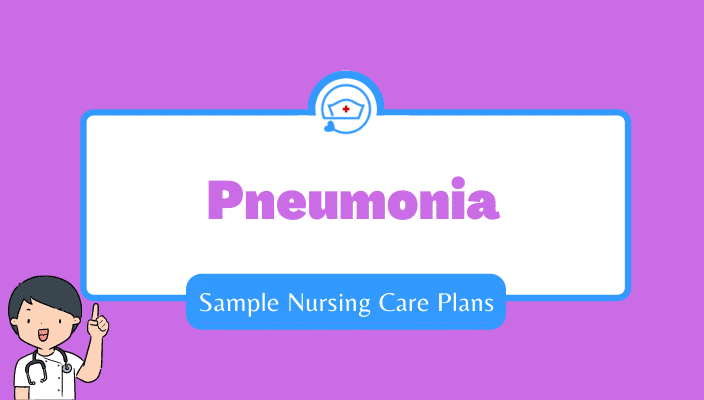Here you will find a scenario-based sample nursing care plan for upper GI bleed. It will include three sample nursing care plans with NANDA nursing diagnoses, nursing assessment, expected outcome, nursing interventions with rationales.
Hypothetical Case Scenario for Upper GI Bleed
A 68-year old male presents to the ED with complaints of fatigue, stomach pain, and vomiting for 3 days. The patient reports that his emesis appears brown and granular, similar to coffee grounds, and his stool is black and tarry. He has a past medical history of arthritis, GERD, and hypertension. When asked about his home medications, the patient reveals that he takes ibuprofen every day, twice a day, to manage his arthritis symptoms.
Upon assessment, the patient appears pale and lethargic. He complains of 8/10 stomach pain and says that the pain is worse when his stomach is empty. His heart rate is 107 BPM, blood pressure is 91/43 mmHg, respiratory rate is 22 breaths per minute, and oxygen saturation is 96% on room air. The patient is alert and oriented and lung sounds are clear.
The patient’s CBC reveals low hemoglobin and hematocrit of 7.2 g/dL and 24.2% respectively. A stool sample is sent and the stool guaiac test is positive for occult blood. In addition, the stool culture detects Helicobacter pylori. An endoscopy is performed, confirming the presence of a stomach ulcer.
The patient is admitted to the hospital with an Upper GI Bleed.
#1 Sample Nursing Care Plan for Upper GI Bleed – Fluid volume deficit
Nursing Assessment
Subjective Data:
- The patient reports fatigue
Objective Data:
- The patient appears pale and lethargic
- Low hemoglobin and hematocrit
- Hypotension
- Stool sample positive for occult blood
Nursing Diagnosis
Fluid volume deficit related to blood loss as evidenced by fatigue, hypotension, and low hemoglobin and hematocrit
Goal/Desired Outcome
Short-term goal: The patient’s blood pressure will normalize and the CBC will remain stable with no worsening signs of bleeding by the end of the shift
Long-term goal: The gastric ulcer will heal and the patient will experience no further episodes of GI bleeding
Nursing interventions with rationale for upper GI bleed – Fluid volume deficit
| Nursing Interventions | Rationales |
| Transfuse packed red blood cells | A blood transfusion may be required to increase the hemoglobin and hematocrit until the bleeding can be controlled |
| Administer IV fluids | Fluid administration will correct the hypovolemia and increase the blood pressure |
| Prepare the patient for an endoscopy | During an endoscopy, the ulcer can be clipped or sutured to halt the bleeding. A follow-up endoscopy may also be ordered because evidence shows a significantly lessened risk of re-bleeding when a repeat procedure is performed |
| Initiate a continuous Protonix infusion | PPI infusion significantly reduces bleeding and re-bleeding of gastric ulcers |
| Closely monitor for signs of re-bleeding | It’s important to closely monitor CBCs for any sudden decreases in blood count. Hypotension, nausea, and vomiting are other signs that re-bleeding may be occurring |
| Maintain strict intake and output documentation | Close documentation of I&O will help determine the patient’s fluid status and guide the plan of care. Documentation of emesis and stool is also important to monitor for improvement |
#2 Sample Nursing Care Plan for Upper GI Bleed – Acute pain
Nursing Assessment
Subjective Data:
- The patient complains of 8/10 stomach pain
Objective Data:
- Heart rate 107 BPM
- H-pylori detected in stool
- Stomach ulcer confirmed via endoscopy
Nursing Diagnosis
Acute pain related to stomach ulcer secondary to Helicobacter pylori infection as evidenced by reports of 8/10 stomach pain
Goal/Desired Outcome
Short-term goal: The patient experiences a reduction in pain and rests quietly for the duration of the shift.
Long-term goal: The patient’s stomach ulcer will heal and his arthritis pain will be adequately managed
Nursing interventions with rationale for upper GI bleed – Acute pain
| Nursing Interventions | Rationales |
| Administer non-NSAID pain medications for pain relief | Medications such as Tylenol have been shown to help with gastric ulcer pain. NSAIDs such as Ibuprofen and Naproxen should not be administered |
| Maintain NPO status until stabilized | If the patient re-bleeds or requires a repeat endoscopy, the procedure can be performed emergently without having to wait to resume NPO status. Also, “resting” the stomach can help the stomach lining heal |
| Administer antibiotics | Antibiotics will treat the underlying Helicobacter pylori infection, allowing the stomach ulcer to heal |
| Anticipate a long-term prescription of a histamine H2 antagonist | Prescribed for a minimum of 4 weeks, medications such as Zantac or Pepcid work by blocking histamine receptors and decreasing the amount of acid in the stomach. |
| Educate the patient about long-term PPI prescription | The patient will be prescribed a proton pump inhibitor such as Protonix or Prilosec for 4-8 weeks. PPI’s decrease the amount of stomach acid in the stomach, thus allowing the ulcer to heal |
#3 Sample Nursing Care Plan for Upper GI Bleed- Knowledge deficit
Nursing Assessment
Subjective Data:
- The patient reports frequent ibuprofen use to manage arthritis pain
Objective Data:
- Helicobacter pylori found in stool
- Stomach ulcer confirmed on endoscopy
Nursing Diagnosis
Knowledge deficit related to factors contributing to ulcer formation as evidenced by patient’s admission about frequent ibuprofen use
Goal/Desired Outcome
Short-term goal: The patient will verbalize how ibuprofen use contributed to the formation of a stomach ulcer by the end of the shift
Long-term goal: The patient will utilize other pain-relief strategies to manage arthritis pain
Nursing interventions with rationale for upper GI bleed – Knowledge deficit
| Nursing Interventions | Rationales |
| Educate the patient about discontinuing NSAIDs | Long-term use of NSAIDs increases the risk of developing a gastric ulcer by interfering with the protective mucosal lining of the stomach |
| Educate the patient about alternative, non-pharmacological strategies to manage arthritis pain | Meditation, acupuncture, massage, and physical therapy are a few examples of non-pharmacological ways to reduce arthritis pain |
| Advise the patient to refrain from drinking alcohol | Alcohol consumption significantly increases the risk of gastric bleeding |
| Educate the patient on Helicobacter pylori | H-pylori is acquired through contaminated food or water. Symptoms include nausea, vomiting, unintentional weight loss, and pain when the stomach is empty |
Conclusion
Here you have learnt how to create a nursing care plan for a patient with Upper GI Bleed. Including nursing assessment, NANDA nursing diagnosis, expected outcome, and nursing interventions with rationales.
Reference
Ackley, B., Ladwig, G., Makic, M., Martinez-Kratz, M., & Zanotti, M. (2020). Nursing Diagnoses Handbook: An Evidence-based Guide to Planning Care (12th ed.). Elsevier.
Herdman, T., Kamitsuru, S. & Lopes, C. (2021). NURSING DIAGNOSES: Definitions and Classifications 2021-2023 (12th ed.). Thieme. Swearingen, P. (2016). ALL-IN-ONE CARE PLANNING RESOURCE (4th ed.). Elsevier/Mosby.




